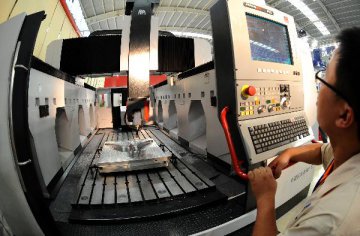
The Fifth Plenary Session of the 18th Communist Party of China Central Committee will be held this month. After the Third Plenary Session held in 2013 decided to comprehensively deepen reform and the Fourth Plenary Session held in 2014 arranged ruling the country by law, the Fifth Plenary Session to be held in October 2015 will plan for building a well-off society in an all-round way and study suggestions for formulating the “Thirteenth Five-Year” Plan for national economy and social development.
Journalist of the Economic Information Daily learnt from several experts that considering the increasing economic downward pressure, it is still possible that the expected economic growth during the “Thirteenth Five-Year” plan will be lowered from 7 percent during the “Twelfth Five-Year” plan to 6.5 percent. The deepening reform will be further quickened in next five years to meet the target of two “doubles” proposed on the 18th Communist Party of China Central Committee regardless of whether the expected economic growth target will be reduced or not.
Constrain: build a well-off society in an all-round way
Since the first five-year plan was formulated in 1953, China has now totally formulated 12 five-year plans. Many of the plans led the important turning points of China’s economy.
The “Thirteenth Five-Year” plan is predestinated to be one of the most critical five-year plans. On the one hand, the “Thirteenth Five-Year” plan is a plan aiming at China’s first 100-year goal, building a well-off society in an all-round way by 2020. The plan also paves way for China’s second 100-year goal which aims at basically realizing modernization by 2049.
On the other hand, China is now undergoing a critical period in which the digestion of excessive capacity earlier, the shift of economic growth and the pains of structural transformation overlap with each other. Traditional growth mode is hard to sustain, while new growth impetus is still forming; population dividend is disappearing and export is slowing down. Understanding, adapting to and leading the new normal will be the idea behind China’s economic development at present and in a certain period in the future.
Argue: whether the growth target should be reduced or not
The report of the 18th Communist Party of China Central Committee proposes to build a well-off society by 2020; as to “sustainable and healthy economic development”, the Gross Domestic Product (GDP) and the per capita income of urban and rural residents should be doubled compared with that of 2010.
Faced with the overlapped difficulties, it is really hard to maintain economic growth. According to latest prediction made by the Chinese Academy of Social Sciences (CASS), the economic growth this year might fall below government’s expectation for the first time in years. Since the economic growth slows down in recent years, the pressure on stabilizing growth increases. Some people believe that the expected economic growth during the “Thirteenth Five-Year” plan can be reduced to 6.5 percent and their reasons are as follows:
Firstly, assuming that China’s GDP will expand 7 percent in 2015, its economy should only maintain an annual growth rate of 6.6 percent during the Thirteenth Five-Year Plan period if it wants to achieve the target of doubling its GDP and per capita incomes for urban and rural residents from 2010. From a subjective perspective, there is not much reason for the CPC Central Committee to such a high economic target. Yet from an objective perspective, as factors driving economic growth, including capital, labor, land and total factor productivity, are on a downward trend, China’s GDP can hardly continue to grow at a rate of 7 percent.
Secondly, there are precedents for lowering economic growth target: the Twelfth Five-Year Plan lowered the GDP growth target to 7 percent from 7.5 percent set in the Eleventh Five-Year Plan.
Thirdly, the economic growth target is only an indicator used for reference. To achieve the target should be based on the premise that “major progress should be made in changing the growth model and that China's development should become much more balanced, coordinated and sustainable. Therefore, the adjustment in economic structural and quality of economic growth will be more importance during the Thirteenth Five-Year Plan period.
Yet there are also disagreements. Zhu Zhenxin, a macro-economic researcher at Minsheng Securities Co., Ltd., believed that although the 6.5 percent target seems a more reasonable choice, yet 7 percent may be a practical one.
Forced: deepening reform to accelerate
The economic growth target is a guideline for economic policies. If China sets its target at 6.5 percent, its GDP can easily double, but there will risks of doubling per capita income. In face of the mounting pressures brought by economic downturn during the Twelfth Five-Year Plan period, the income indicators for rural and urban residents have diverged. The incomes of urban residents have expanded at a slower pace than GDP in recent. If the trend will continue in the Thirteenth Five-Year Plan period, the economy has to grow faster.
Wang Yiming, deputy director of the Development Research Center of the State Council, believes that so long as China adapts to the New Normal, sticks to reform and innovation and take active actions, China’s economy will keep growing at a rate of about 7 percent and steadily step to a mid and high-level, thus laying a solid foundation for achieving the “Two Centenary” Goals.
How to unleash the potentials for growth? The Standing Committee of the National People's Congress proposes on a report on special research on some important issues concerning the preparation of the outlines for the “Thirteen Five-Year Plan” that the key to solve crucial problems and ensure the realization of economic and social development objectives and major strategic tasks is to deepen the reforms in an all-round way and to form an effective incentive and interest coordination mechanism, with the core of correctly handling with the relations among the government, the market and the society.
Lian Ping, chief economist at Bank of Communications Co., Ltd. (601328.SH), believes that after another round of reform, opening-up, transformation and innovation, China is capable of making total factor productivity instead of capital accumulation an engine of its economic growth, which will prevent it from sinking into a “middle-income trap” and help it enter a “New Normal”. The marketization reform will be a key for the transformation of China’s growth pattern.
Translated by Jennifer Lu and Coral Zhong
























Latest comments